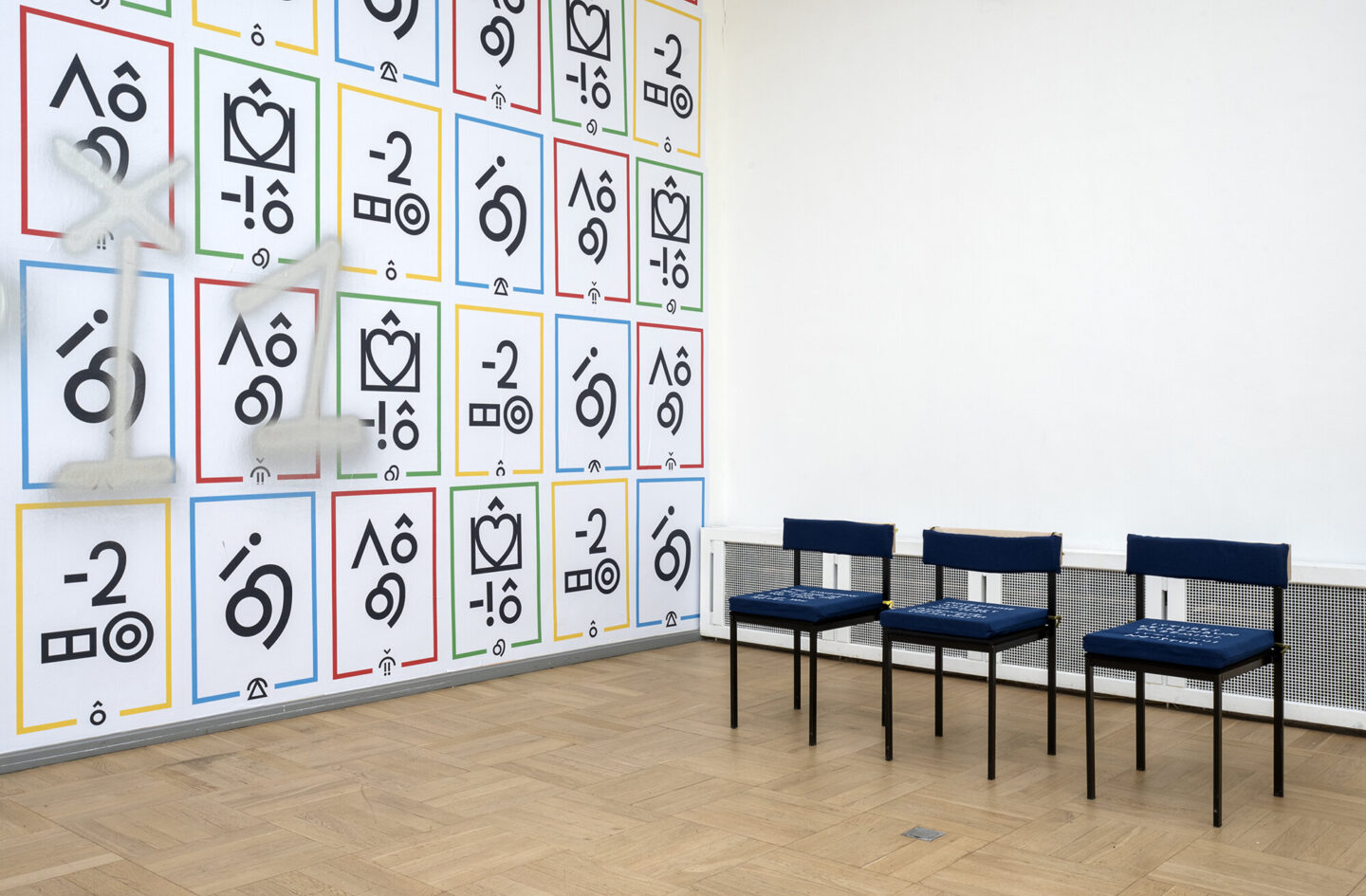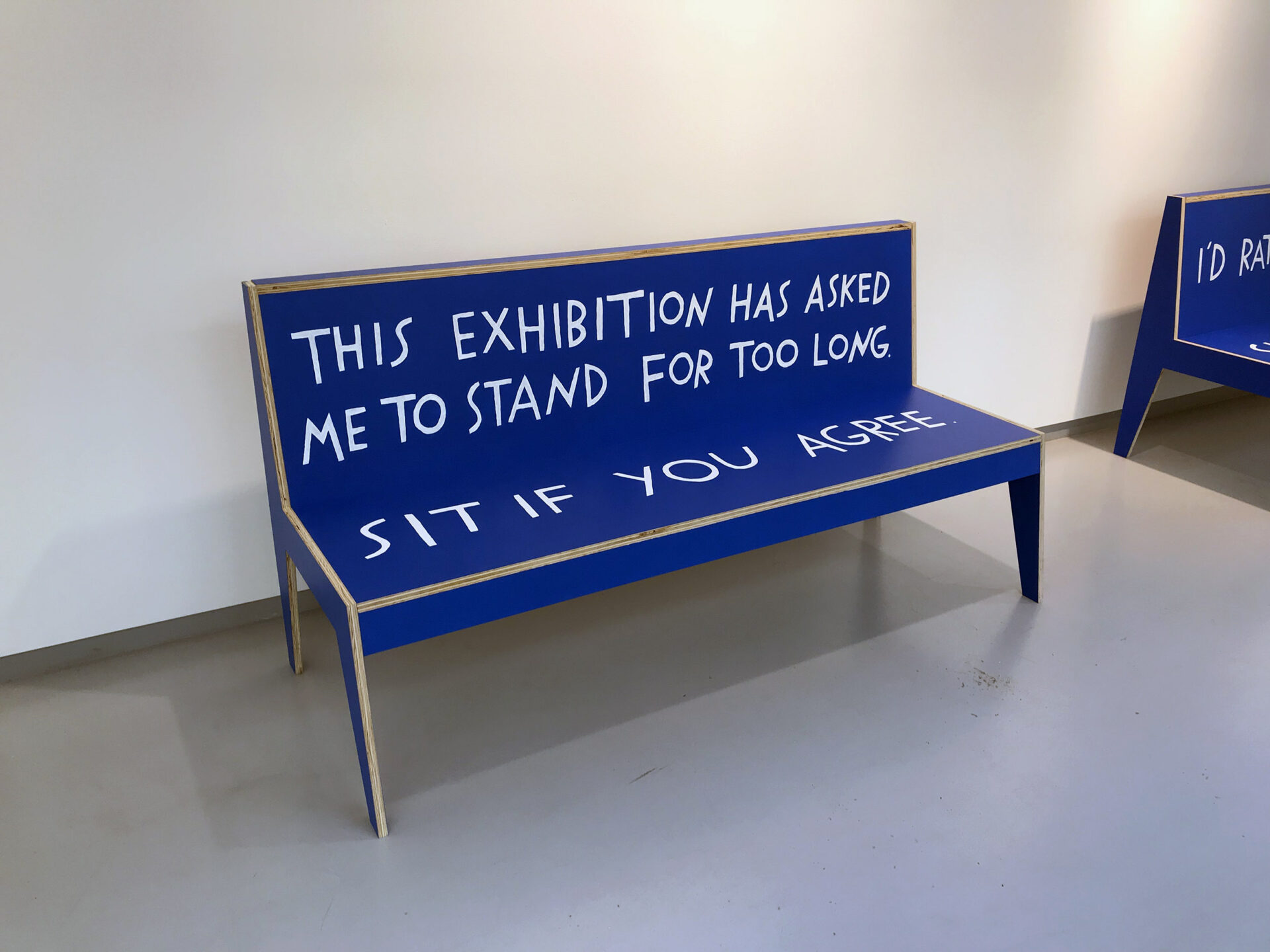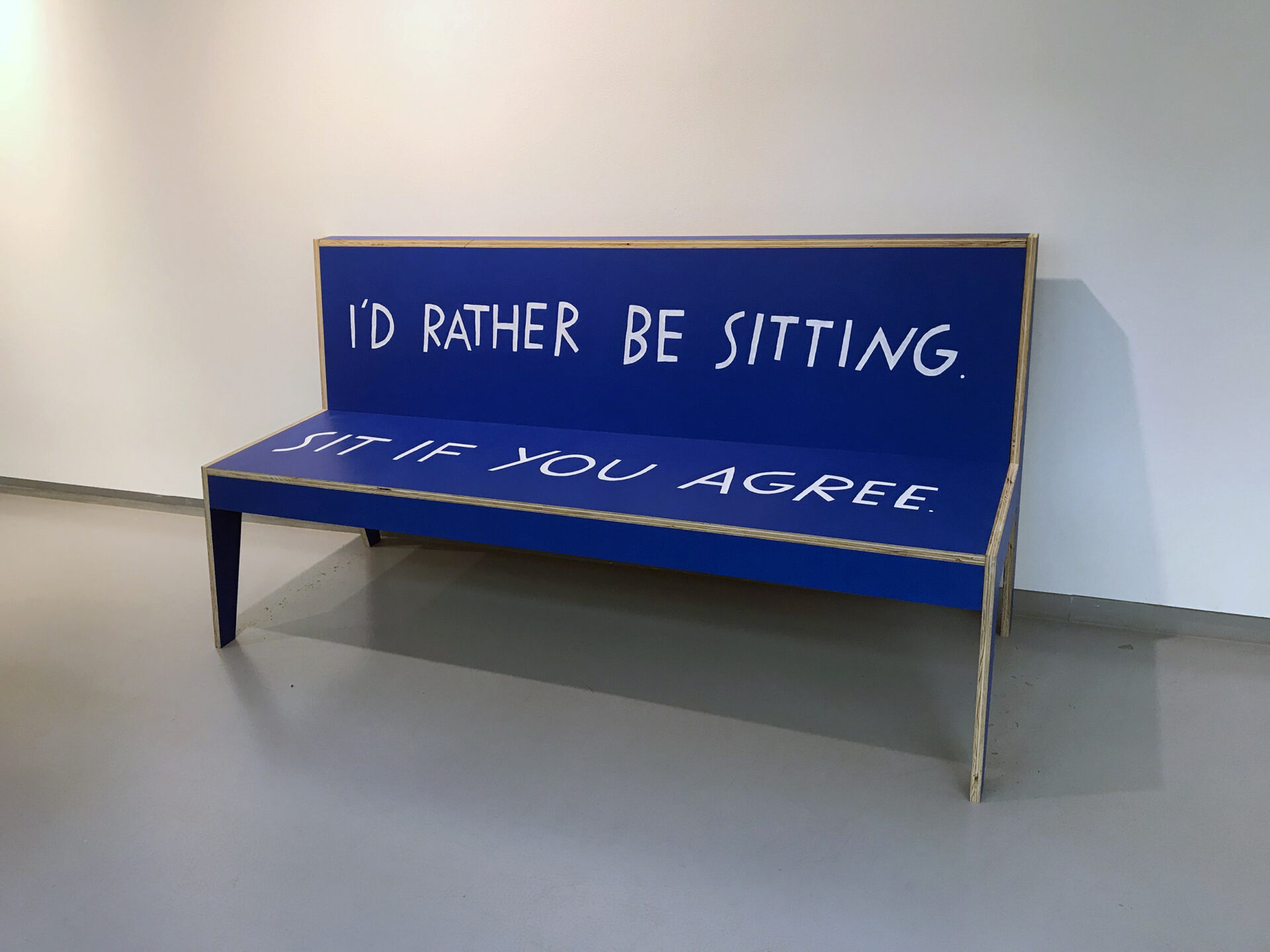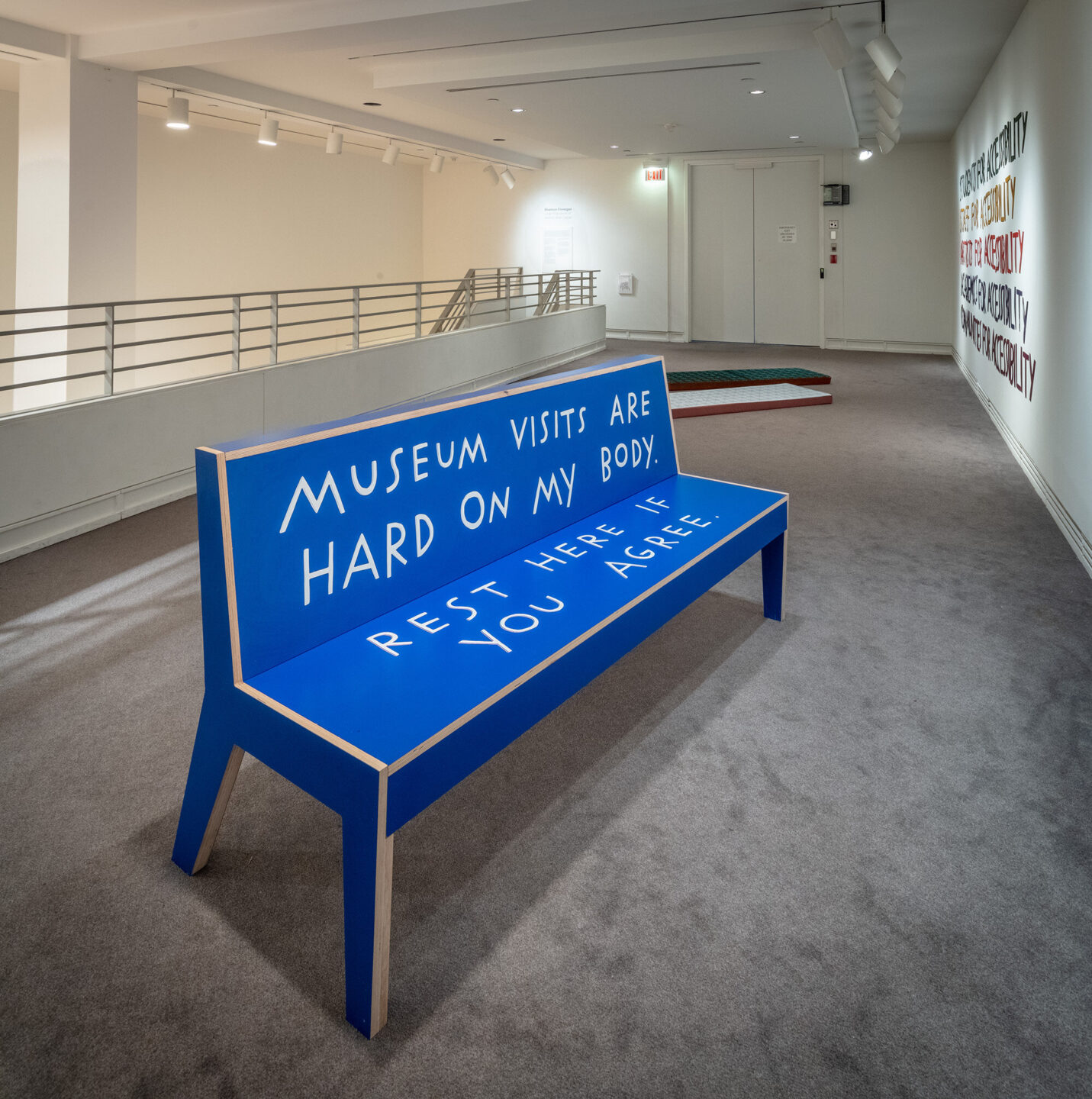Do You Want Us Here or Not: Fighting for Accessibility in Art Spaces


For the second edition of our essay series at Art Düsseldorf Magazine, we asked a selection of writers to investigate issues related to Diversity in the Art World. This essay by Delia Harrington, a Boston-based journalist, explores the fight to create more disability-friendly museum spaces.
Edited by: Chris Erik Thomas, Digital Editor of Art Düsseldorf.
About a year ago, I saw a photo online of a bright blue bench with the words: “This exhibition has asked me to stand for too long. Sit if you agree.” The piece turned out to be from the series “Do You Want Us Here or Not” by disabled artist Finnegan Shannon. Other benches say things like ”I would rather be sitting. Sit if you agree,” and “It was hard to get here. Rest here if you agree.” The one in my own backyard at the Museum of Fine Arts, Boston, says: “Museum visits are hard on my body. Rest here if you agree.”
I immediately felt a zing of recognition on seeing these pieces; a brilliant response suited to the setting. In a profoundly literal way, Shannon is able to offer solidarity and respite to fellow disabled folks (and others who simply need a rest!) in art spaces through their work. While Shannon’s art expands well beyond the bench to other furniture and objects like chairs, seats, and stair-transforming cushions — as well as creating disabled spaces that verge on performance art — there is a beautiful simplicity to the bench. As Shannon explains, the distinctive bright blue and white color scheme is partially in reference to the international symbol of access; it’s also because blue is vibrant and high contrast, meeting a different accessibility need. These works are not merely for awareness. They provide an immediate, albeit small-scale, solution to the problem they are pointing out.
The benches are a direct address to those who need them. A reminder of how ableist and unwelcoming to disabled and aging people art spaces can be: you can sit on this bench, even if there’s literally nowhere else to do so. That was very much intentional. As Shannon learned through conversations with curators, many museums have seating in storage but decline to use it as a curatorial choice — a deeply frustrating admission that tracks with my experience. When I come across seating, it isn’t always in logical places and is often high on aesthetics and low on practicality. It was this nugget of discovery, plus their own accessibility needs, that pushed Shannon to conceive of the series. “If I make an artwork that is also seating, that’s a way of working around that,” they explained. Shannon initially came up with the idea for the bench and other similar ideas in 2017 when they drew sketches and posted them on Instagram. The drawings were always meant to become tangible, functional pieces of furniture in the real world, and they had the first bench made in 2018.
Encountering Shannon’s work has made me hyper-aware of how many art spaces have no seating or, worse, have bench- and chair-like objects that are part of the interior design yet are forbidden to sit on by visitors. I find myself taking photos of these non-seating areas in museums and galleries, as well as the rare encounters with actual places to sit, and sharing them on social media in between works of art. One bench I came across recently in an Austin museum, though not explicitly forbidden as a seating option, had a metal bar protruding midway down the backrest, making it unusable in a practical sense. It was reminiscent of so-called “hostile architecture,” which is made to prevent “undesirable” groups like skateboarders and unhoused people from using it — like benches with dividers or bridges with spikes under them to prevent people from comfortably sleeping there. As with hostile architecture, this kind of design choice sends a message about who is and isn’t welcome in a particular space. Would it really be so bad if we sat?
Beyond feeling personal, Shannon’s work is visceral to me; I see it, and my sore body longs to rest while my frustrated mind wonders what took so long for seating to be allowed. My constellation of chronic illnesses kicked into high gear during the pandemic, often leaving my body sore, overheated, and weak. It can come on suddenly, and if I only went out when I felt my best, I wouldn’t get much of anything done. Often, when I first arrive somewhere, I need to sit, cool down, and collect myself. It’s not uncommon for me to need to sit at random times throughout the day and rest, drink water, take medication, or otherwise tend to my body’s needs. I also tend to take in art slowly. I circle a piece, seeing it from every vantage point and multiple distances, and when I lock in on a work that moves me, I appreciate a place to sit and consider it at length, maybe even write about it for a while.
Ever since I first saw a picture of Shannon’s work, I’ve found myself telling anyone and everyone about these functional works of art. As often happens when a disabled person speaks up to assert their needs, their work has made me feel more comfortable asserting my own needs and more aware of who else’s needs might not be met. Moreover, I’ve noticed that discussing the series has the effect of giving others permission to take whatever break they might need at that moment, even without Shannon’s bench being physically present — thus extending their work’s sphere of influence far beyond its physical location. Identifying as disabled is something of a journey, and the term is loaded. But the act of sitting on a bench, one that explicitly belongs in the space and people are encouraged to use, is simply taking part in the museum-going experience. Even for those sitting on a different bench in a different museum, knowing that others need benches just like they do, to the extent that there is functional art about it, provides a level of assurance that taking a seat is okay.

Finnegan Shannon. Bench from the “Do You Want Us Here or Not” series, 2018. MDO, paint. 72"L x 26"W x 36"H. Designed in consultation with Charles Mathis and Chat Travieso, fabrication by Charles Mathis.

Finnegan Shannon. Bench from the “Do You Want Us Here or Not” series, 2018. MDO, paint. 72"L x 26"W x 36"H. Designed in consultation with Charles Mathis and Chat Travieso, fabrication by Charles Mathis.
As the series passes the five-year mark, Shannon has been thinking about curation and longevity. They have been toying with the idea that the pieces never end, of each work being “continually in the process of being made by use and repair.” They’re creating clear documentation about their priorities and instructions for conservators for the works’ lifespan to ensure that the focus is on the functionality of the pieces before anything else. “I would much rather that the piece continue to be used and repainted than have it used less in order to conserve the specific original paint job.” As a result, as these works age, they will naturally diverge from one another due to wear and tear and maintenance, all of which are part of the work itself. I love the idea of the artwork being in service to people who need it; being a good, strong, usable place to sit is its highest function.
With Shannon’s curation notes focusing on functionality over preserving the original state of the work, it brings up a question: what is the true nature of the work itself? Is it a blue and white bench with a certain type of lettering or a certain color of paint? Or is it the lifespan of a bench acting in service to so many different people — the act of providing a place to sit while provoking important conversations and everything that happens on, around, and to that bench during its many years of existence? It reminds me of Walter de Maria’s “Calendar” (1961-1965), which takes a year to experience fully. Or Félix González-Torres’s series of “Candy Works,” each an endless supply of individually wrapped candies that replenish indefinitely, per the artist’s instruction. Regardless of whatever may happen to any of the benches in the short term, they will be repaired, per Shannon’s instructions, to continue to serve their functions.

Finnegan Shannon. Bench from the “Do You Want Us Here or Not” series, 2020. Baltic birch, poplar wood, plastic laminate. 73.5"L x 27"W x 35.5"H. Commissioned for Lone Proponent of Wall-to-Wall Carpet at Carleton University Art Gallery. Fabrication by Walter Zanetti, Anthony Dewar, Paul Durocher, School of Industrial Design, and Brant Lucuik, School of Architecture, of Carleton University. Photos by Justin Wonnacott.
Accessibility is not a one-size-fits-all set of needs, and there’s frankly plenty more room for improvement within the art world beyond this one issue. It’s not uncommon for art institutions, especially those in older buildings or alternative spaces, to simply not have any elevator access, cutting off access to those with mobility needs. Shannon points out that disability and fat liberation are deeply intertwined, which is one of the reasons their benches are so strong. What would it look like if art institutions were more welcoming to fat bodies across the board? I want to see art spaces become more accessible for all across many different accessibility needs. I want to see art spaces full of art from disabled artists, whether dealing directly with disability or not.
Unlike many artists, Shannon looks forward to a day when this particular series ends. “Part of my hope is really that the work becomes not needed.” They would love to see “a rich and varied set of [seating] options in museum spaces.” They explained, “The goal for me is not that every space needs one of these benches, but more that from the work, people are thinking more about what could happen in those spaces.” An easy answer is for museums and galleries to dust off some of that seating that so many of them apparently already keep in storage. Actively soliciting feedback from the public on the topic is one way to get recommendations tailored to the individual institution. Budgeting for accessibility and prioritizing it over aesthetics are both essential. Whatever solution they choose, the most important thing is that institutions include disabled people with a variety of access needs in these conversations so they hear directly from us — and then actually take action.